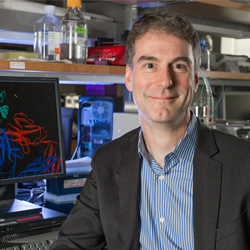
T-cells, which hunt for traces of disease within other cells, work by identifying fragments of outsider proteins on a diseased cell’s surface and then go in for the literal kill.
With cancer, some of the mutated fragments of outsider proteins, called neoepitopes, can be recognized by T-cells and are ideal candidates for cancer vaccines. Unfortunately, those candidates are difficult to predict from genetic data alone.
A study published this month in Nature Chemical Biology by Brian Baker, the Rev. John A. Zahm Professor of Structural Biology and chair of the Department of Chemistry and Biochemistry at the University of Notre Dame, and collaborator Alexandre Harari at the Ludwig Institute for Cancer Research at the University of Lausanne (UNIL) in Lausanne, Switzerland shows that to improve those predictions and develop cancer vaccines, researchers need to think more about what neoepitopes look like in three dimensions.
“This is where immunology and immunotherapy can get stuck, because it often comes down to structural biology and biophysics – in this case the neoepitope physically looks different from a fragment from a healthy cell, and this has immunological consequences,” Baker said.
T-cells, a type of white blood cell, have long been known to target cells infected by viruses, but they also identify and eliminate cancer cells as part of the body’s normal immune response to cancer. Many researchers have sought to take advantage of this process by generating therapeutic vaccines which help boost this naturally occurring anti-cancer immune response.
The process of targeting a cancer cell is more difficult for T-cells than the process of targeting a virally infected cell. This is in part because the neoepitopes on cancer cells are very similar to protein fragments derived from healthy cells in the human body, while neoepitopes from viruses are completely foreign and easier for T-cells to identify. In general, the more a T-cell target differs from healthy fragments, the more likely T-cells will see it and initiate an immune response.
In studying a neoepitope from ovarian cancer, Baker found that, more than anything else, the way the neoepitope was shaped—or its three-dimensional structure—is what drove T-cell recognition.
“The structure looks different in a way you would not easily predict by simply considering the amino acid sequence,” Baker said. “The structural and biophysical differences allow the T-cell to stick and do its job. The T-cell is able to say ‘Aha! You should not be there. I see you - gotcha.’” Baker said.
The structural and biophysical work performed in Baker’s lab built on pioneering bioinformatic and immunological studies performed at the Ludwig Institute. The next steps are to learn how to capture these structural principles using modeling techniques, which are quickly evolving and improving.
“Ultimately, incorporating accurate structural modeling could be a quantum leap in generating cancer vaccines,” said Baker, who is affiliated with the Harper Cancer Research Institute.
In addition to Baker, others who contributed from Notre Dame include lead author and former graduate student Jason R. Devlin, as well as Jesus A. Alonso, Cory M. Ayres, and Grant L.J. Keller. Other researchers are from the Department of Oncology UNIL Centre Hospitalier Universitaire Vaudois (CHUV), Ludwig Institute for Cancer Research at UNIL, Switzerland; the Center of Experimental Therapeutics at Centre Hopsitalier Universitaire Vaudois, Lausanne, Switzerland, the Department of Molecular and Cellular Biology at the University of Kentucky, Lexington, and the Swiss Institute of Bioinformatics, Lausanne, Switzerland.
The research at Notre Dame was funded by a grant from the National Institutes of Health.